
Early Retirement
| You’ve probably heard of layering clothing when you pack for travel -- but you can also layer BAGS |
| Five Tips on Packing Light |
Many folks are surprised at how little we carry
when we travel, especially considering how
long some of our trips are -- often two or three
months. Making packing even more challenging
is the fact that our trips rarely involve just one
kind of clothing such as beach wear but rather
tend to include a range of climates and modes
of travel (e.g., cruise and trek). But the benefits
of bringing less are so great that we strive to
make it happen -- and we're always grateful we
did once we hit the road.
This photo shows what I usually bring on nearly
any trip, no matter what the length. Robin (bless
her) brings about the same. What makes our
approach unique is that we not only layer our
clothing, which just about every inveterate
traveler recommends, but also our BAGS. By
carrying 1) a convertible carry-on, 2) a small
daypack, and 3) an even smaller PacSafe, each
of which nests inside the other, we can travel
both lightly and securely.
when we travel, especially considering how
long some of our trips are -- often two or three
months. Making packing even more challenging
is the fact that our trips rarely involve just one
kind of clothing such as beach wear but rather
tend to include a range of climates and modes
of travel (e.g., cruise and trek). But the benefits
of bringing less are so great that we strive to
make it happen -- and we're always grateful we
did once we hit the road.
This photo shows what I usually bring on nearly
any trip, no matter what the length. Robin (bless
her) brings about the same. What makes our
approach unique is that we not only layer our
clothing, which just about every inveterate
traveler recommends, but also our BAGS. By
carrying 1) a convertible carry-on, 2) a small
daypack, and 3) an even smaller PacSafe, each
of which nests inside the other, we can travel
both lightly and securely.
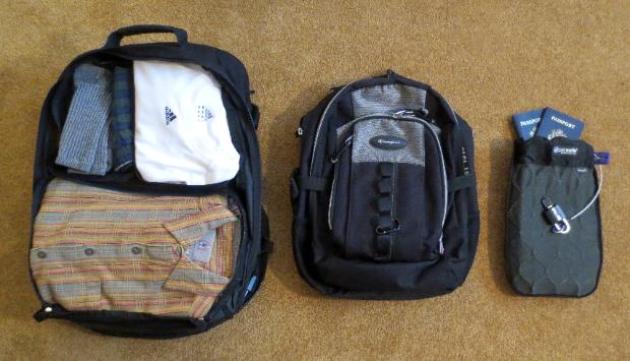
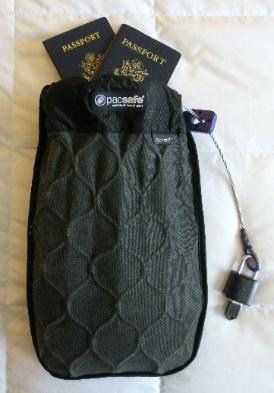
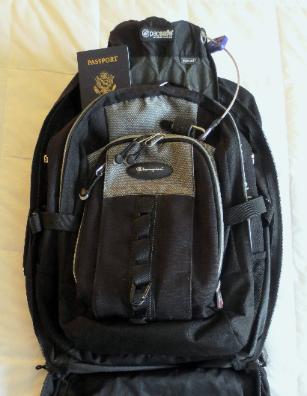
| 4. Downsize Electronics |
Electronics can make up a significant portion
of the total weight of your bag, so learning to
keep these items as light as possible can make
a real difference in how much you enjoy your
trip. We travel with a lightweight and compact
laptop. A pocketsize Canon PowerShot camera
with charger and extra battery gives us all we
need for taking quality photos. We also bring
iPod Shuffles for music and a tiny handheld
microphone and ear buds for Skyping. We rely
primarily on email and Skype to stay in touch
with family and friends when traveling.
of the total weight of your bag, so learning to
keep these items as light as possible can make
a real difference in how much you enjoy your
trip. We travel with a lightweight and compact
laptop. A pocketsize Canon PowerShot camera
with charger and extra battery gives us all we
need for taking quality photos. We also bring
iPod Shuffles for music and a tiny handheld
microphone and ear buds for Skyping. We rely
primarily on email and Skype to stay in touch
with family and friends when traveling.
| 1. Use a Convertible Carry-On Bag |
We use Rick Steves convertible carry-on bags
(shown at right) for nearly all of our trips, and
we swear by them. They quickly convert from
regular carry-on luggage into backpacks. If you
can comfortably fit all your belongings into one
of these bags, then you’re doing quite well
packing-wise. If the bag is bursting at the
seams, then you’re probably bringing too much
and should lighten up a bit. The bags open up
fully so you can easily see all your belongings.
Zippered compartments let you organize your
stuff, and you can use the mesh packing cubes
included with the carry-on bag to keep the
main compartment organized.
The bag’s backpack straps easily stow away for
airline travel or whenever you want your bag to
look less like a backpack. They're also sized for
carry-on so we never have to check them,
which means we never lose our luggage. They
even have a zippered expander that lets you fit
in a few extra gifts and souvenirs at the end of
your journey.
(shown at right) for nearly all of our trips, and
we swear by them. They quickly convert from
regular carry-on luggage into backpacks. If you
can comfortably fit all your belongings into one
of these bags, then you’re doing quite well
packing-wise. If the bag is bursting at the
seams, then you’re probably bringing too much
and should lighten up a bit. The bags open up
fully so you can easily see all your belongings.
Zippered compartments let you organize your
stuff, and you can use the mesh packing cubes
included with the carry-on bag to keep the
main compartment organized.
The bag’s backpack straps easily stow away for
airline travel or whenever you want your bag to
look less like a backpack. They're also sized for
carry-on so we never have to check them,
which means we never lose our luggage. They
even have a zippered expander that lets you fit
in a few extra gifts and souvenirs at the end of
your journey.
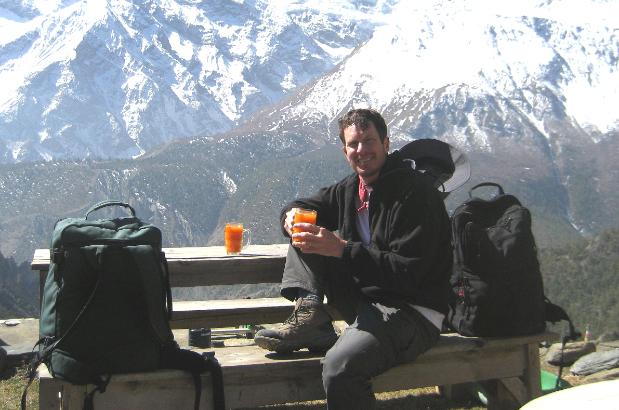
| Our convertible backpacks worked great during our one-month Annapurna Circuit in Nepal |
| 2. Bring a Small Daypack |
A daypack with lots of dividers and zippered
compartments holds all of our electronics,
papers, guide books, and incidentals. It fits
inside our larger bag when we’re trekking or
simply walking from point to point.
When we get to a bus or taxi, we can quickly
pull out the daypack filled with the passports,
electronics, and other things we really care
about and keep it close at hand, while allowing
our convertible backpacks now filled with just
clothes to be stored worry-free in the vehicle’s
outer compartment or trunk. I usually carry the
electronics-filled daypack, while Robin brings a
smaller microfiber daypack (a Rick Steves
"Civita" daypack, to be specific) that packs
down to almost nothing and can be used for
actual day trips when needed. Once we arrive
at our lodgings, the carry-on bags and primary
daypack stay put in our room.
compartments holds all of our electronics,
papers, guide books, and incidentals. It fits
inside our larger bag when we’re trekking or
simply walking from point to point.
When we get to a bus or taxi, we can quickly
pull out the daypack filled with the passports,
electronics, and other things we really care
about and keep it close at hand, while allowing
our convertible backpacks now filled with just
clothes to be stored worry-free in the vehicle’s
outer compartment or trunk. I usually carry the
electronics-filled daypack, while Robin brings a
smaller microfiber daypack (a Rick Steves
"Civita" daypack, to be specific) that packs
down to almost nothing and can be used for
actual day trips when needed. Once we arrive
at our lodgings, the carry-on bags and primary
daypack stay put in our room.
| 3. Use a Pac-Safe Bag for Valuables |
A small PacSafe mesh-lined bag lets us lock up
passports, extra cash, credit cards, ATM cards,
small electronics, and any other sensitive
documents or possessions we don’t need
while away from our room. Simply attach it to a
bed railing, solid piece of furniture, or pipe,
preferably out of sight. Meanwhile, a simple
laptop locking cable keeps our laptop safe.
While a determined criminal could certainly
defeat these simple measures, they serve as a
deterrent to casual theft, which tends to be the
most common issue when traveling.
The PacSafe bag is small enough that it fits
snugly inside the daypack along with our other
electronics. Thus we have a triple layering of
bags, one inside the other, which we’ve found
works very nicely indeed for life on the road.
Tip: Take your PacSafe bag out of hiding and
stow it inside your daypack the night before
you head off for another destination so you
don’t unintentionally leave it behind.
passports, extra cash, credit cards, ATM cards,
small electronics, and any other sensitive
documents or possessions we don’t need
while away from our room. Simply attach it to a
bed railing, solid piece of furniture, or pipe,
preferably out of sight. Meanwhile, a simple
laptop locking cable keeps our laptop safe.
While a determined criminal could certainly
defeat these simple measures, they serve as a
deterrent to casual theft, which tends to be the
most common issue when traveling.
The PacSafe bag is small enough that it fits
snugly inside the daypack along with our other
electronics. Thus we have a triple layering of
bags, one inside the other, which we’ve found
works very nicely indeed for life on the road.
Tip: Take your PacSafe bag out of hiding and
stow it inside your daypack the night before
you head off for another destination so you
don’t unintentionally leave it behind.
| 5. Layer Clothing & Limit Outer Layers |
Every experienced traveler will tell you the
same thing: less is more. You’ll enjoy yourself
more if you aren’t burdened down like a pack
animal. Try dressing in layers, and limit your
bulky outer layers as much as possible. You can
always buy an extra sweater on the road if you
need one. Quality raingear that packs into its
own pocket is always worth having. That plus a
lightweight fleece jacket goes a long way
towards keeping you warm in inclement weather.
same thing: less is more. You’ll enjoy yourself
more if you aren’t burdened down like a pack
animal. Try dressing in layers, and limit your
bulky outer layers as much as possible. You can
always buy an extra sweater on the road if you
need one. Quality raingear that packs into its
own pocket is always worth having. That plus a
lightweight fleece jacket goes a long way
towards keeping you warm in inclement weather.
| Bonus Tip |
On two occasions I’ve rented cruise formal wear and dress shoes because it was the only
way I could pack light for an extended trip that continued after the cruise. The extra cost
was worth every penny.
way I could pack light for an extended trip that continued after the cruise. The extra cost
was worth every penny.
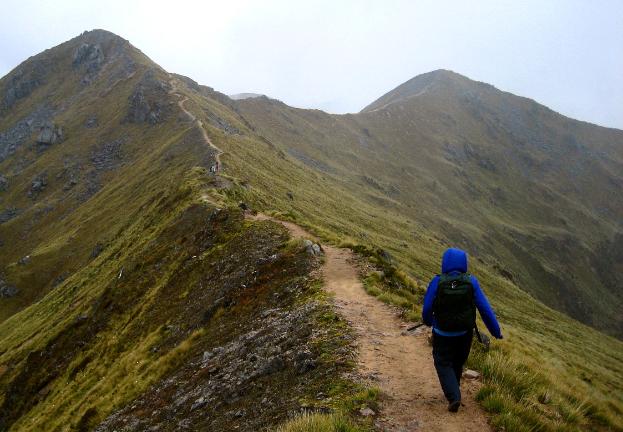
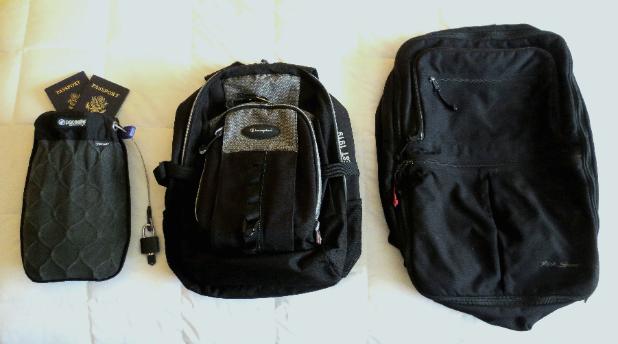
| PacSafe fits into daypack -- daypack fits into convertible backpack -- genius! |
| The PacSafe lets you lock up and leave valuables in your room when you're out exploring |
| This packing system worked well for us during our five-month trip to New Zealand and Fiji, which included everything from multi-day backpacking to beachcombing |